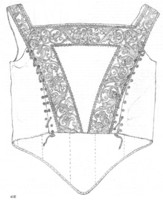
The
Toledo Gown
This gown based on the gown worn by Eleanor of Toledo is a huge favourite of mine. The fabric is a furnishing brocade and works wonderfully for historical dress. The sleeves took over 17 metres of piping cord and more than 80 buttons. I took a standard sleeve pattern in my size and altered it by splicing it into panels adding a little extra to allow for the chemise under neath and then the seam allowance. At the tops of the sleeves I added about an extra 20cm or so to create the loops as seen in the portrait. Each panel was constructed separately and then brought together using the buttons at each joining point. There are buttons at the tops of the sleeves also that attach the sleeves to the shoulder by loops under the shoulder strap of the dress.
The bodice and
sleeves are lined in a cotton drill. Additionally
the bodice is interfaced with a heavy canvas, there was no boning used in the
front of the bodice only the back where the closures are at the side back. The boning ensured
that the lacing didnít collapse when tightened.
The front of the bodice held its shape due to the canvas interfacing and
the corset being worn underneath. The
partlet is made of the closest thing I have found to cloth of gold.
Itís a synthetic organza that was being sold as a table topper in the
Christmas decorations at a major retail outlet.
The edge of the partlet is edged in carnelian and bloodstone beads.
Just as the original gown had a train, so does mine.
Being quite long it makes a difference how you approach certain
situations. The
dress called for large flat pleats in the skirt that needed to be draped to ensure that they
sat just right. I draped cotton drill on
my body double first to get the pattern right before cutting the brocade. This dress dates to
about 1555.

The final logistics for this gown are:
9 metres of 142cm wide brocade (I always buy 10 metres of fabric and normally use it all)
18 metres of piping cord
84 gold metal buttons
2 metres of 112cm wide cotton drill for lining
1 metre of 150cm wide canvas for interfacing
1 metre of gold organza
80 heliotrope beads
80 carnelian beads
200 metres of sewing thread aprox
56 lacing rings
4 - 6 metres of cord for lacing >
1 spool of white beading thread
4 metal bones

The Janet Arnold Book, Patterns of Fashion, 1560 - 1620, is the best resource for researchers wanting to recreate this dress. The sketches are both from her book and from her description of the Toledo burial Gown.
The chemise is made of cotton voile with a draw string neckline. The sleeves are half as long as my arm again so that there is enough to pull out of each of the openings in the sleeve to give that nice little puff effect. The cuff is split and fastens with gold buttons the same as the sleeve, and the cuff is made from lovely bold metallic braid. The very edge of the sleeve is finished in hand tatted lace. This was the best I could find at the time and is 100% hand made cotton lace.
The dress is accessorised with a girdle, coif, string of pearls, small brooch, earrings and rings. See close up images of my mask here.
The bottom image I am wearing a mask. This was for a ball, big hint here, if you are going to have a masked ball, do it in cooler months. The mask is made of plaster although pre 1600, leather was the more likely material used. The Mask has a long history that is some what obscured at times, although one thing is clear, we seem to love wearing them for many reasons.
All intellectual content, composition, layout, designs and photographs, unless otherwise noted are copyright 2007 to Deborah Lane ©, or, copyright 2003 to Deborah Murray © also known as Mistress Oonagh O'Neill ©. All Original renaissance art works and artefacts are not copyright to Deborah Murray, and are shown for educational use only . If you see something you'd really like to use, please contact me!